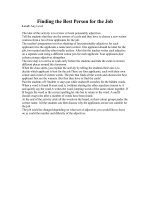Lecture Finding the best evidence
Bạn đang xem bản rút gọn của tài liệu. Xem và tải ngay bản đầy đủ của tài liệu tại đây (808.6 KB, 29 trang )
Step Two
Finding the
best evidence
1. Walk through one
2. Do own searches
Learning through play
Try all “buttons”
Make lots of “mistakes”
Have fun
EBM and Systematic Review
EBM (quick & dirty)
Steps
Answerable Question
Search
Appraise
Systematic Review
Steps
Apply
Time: 90 seconds
< 20 articles
This patient survives!
Answerable Question
Search ++++
Appraise x 2
Synthesize
Apply
Time: 6 months
< 2,000 articles
This patient is dead
Find a systematic review!!
Start up
Start Explorer and enter
Put on CAPS lock
www.pubmed.gov
So that AND and OR are in CAPITALS
Start 2nd Explorer window, enter
www.tripdatabase.com
Using the question to guide
searching
Scenario You are interested in checking the hearing
of elderly patients, and have heard that the
‘whispered voice test’ is good.
Question
Population
Indicator (intervention, test, etc)
Comparator
Outcome
Using the question to guide
searching
Scenario You are interested in checking the hearing
of elderly patients, and have heard that the
‘whispered voice test’ is good.
Question
Population – in elderly patients does
Indicator – a ‘poor’ whispered voice test
Comparator – a ‘normal’ whispered voice test
Outcome – predict abnormal audiogram
Underline the key terms
Number the order of importance from 14
Think of alternate spellings, synonyms, & truncations
1.
2.
3.
Using the question to guide
searching
Scenario You are interested in checking the hearing
of elderly patients, and have heard that the
‘whispered voice test’ is good.
Question
Population – in elderly patients does 3
1
Indicator – a ‘poor’ whispered voice test
Comparator – a ‘normal’ whispered voice test
Outcome – predict poor hearing (audiogram)
2
Underline the (root of the) key terms
Number the order of importance from 14
Think of alternate spellings, synonyms, & truncations
1.
2.
3.
Check the
question type
AND means
both terms
required
* Means any
other letters
Check the
emphasis
Stepwise searching
Search with #1 PICO item
Whisper*
Then go to “Clinical Queries”: diagnosis
Whisper* (again)
Add #2 PICO item
whisper AND (hear* OR audiogram)
Combining terms with
Boolean operators – AND
IN CAPITALS
weight AND chitosan has both terms
weight
chitosan
Combining terms with
Boolean operators – OR
weight OR chitosan has either term
weight
chitosan
Your tasks
Search for the best single article
(systematic review or trial) for
Your question from notes
Your own question(s)
When you are finished
Print just the abstract for each
Write your search strategy on the page
Booleans*
AND = both terms
OR = either term
NOT = not this term
(ADJacent, NEAR, … = AND + close)
* George Boole (a man) is claimed to have invented “logic”
Where to the brackets go?
If you want
Which do you ask for?
cheese AND fruit
cheese AND (apple OR pear OR melon)
(cheese AND apple) OR pear OR melon
What does PubMed do with if AND and OR?
Cheese AND apple OR pear
(Look at DETAILS tab)
General structure of search
(Population OR synonym 1 OR …) AND
(Intervention OR synonym 1 OR …) AND
(Comparator OR synonym 1 OR …) AND
(Outcome OR synonym 1 OR …) AND
FILTER (for best study type)
Comparing Databases
Medline
Embase
Cochrane Trials Registry
Medline = Pubmed, Webspirs, OVID, …
Search Cascade
Shortcuts
Metasearch engines
www.tripdatabase.com
Sumsearch
Nelh
Other tips:
Search on Title only
Eg [ti]
(Others are [au] author; [so], [yr], …)
‘Related Articles’ button
(PubMed)
previously identified study (PubMed)
Look for the MeSH terms
MeSH browser
Before you finish!
Print single most relevant abstract for
each question – for both ‘set’ questions
and your own questions
More Tips on Effective Searching
Decide the TYPE of question (Rx, Dx, Px, …)
Chose the right database for the type of
question, e.g.,
Intervention: Cochrane Library, PubMed, …
Diagnostic: Common Diagnostic Strategies (in BE), or
PubMed: Clinical Queries
Prognosis, Etiology: PubMed: Clinical Queries
Hearing problems in childhood
Scenario An immunisation and screening booklet
asks parents whether they think their child has any
problems with hearing. While on a committee
reviewing these questions, you wonder about the
usefulness of this.
Question
Population
Indicator (intervention, test, etc)
Comparator
Outcome
Question Type Rx, Dx, Px, …
Database
Hearing problems in childhood
Scenario An immunisation and screening booklet
asks parents whether they think their child has any
problems with hearing. While on a committee
reviewing these questions, you wonder about the
usefulness of this.
Question
Population – In well children
Indicator does parental report of concern
Comparator nil
Outcome – predict true hearing problems?
Question Type Rx, Dx, Px, … Diagnostic Accuracy
Database – PubMed: Clinical Queries diagnosis
Using the question to guide
searching
Question
Question Type
Population – (child OR children) AND
Indicator – (parent OR parental) AND
Comparator nil
Outcome – (hearing)
Dx – Diagnostic Accuracy
Database – PubMed: Clinical Queries









